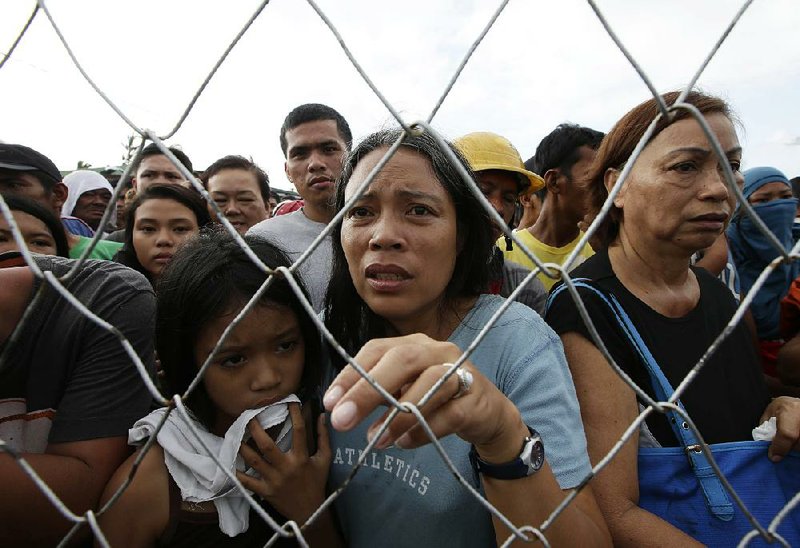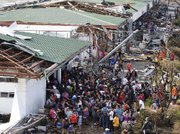TACLOBAN, Philippines - Bloated bodies lay uncollected and uncounted in the streets, and survivors pleaded for food, water and medicine as rescue workers took on a daunting task Monday in the typhoon-battered islands of the Philippines. Thousands were feared dead.
RELATED ARTICLE
http://www.arkansas…">Typhoon Haiyan weighs upon first day of U.N. climate talks
The hard-hit city of Tacloban resembled a garbage dump from the air, with only a few concrete buildings left standing in the wake of one of the most powerful storms to ever hit land, packing 147-mph winds and whipping up 20-foot walls of seawater that tossed ships inland and swept many out to sea.
“Help. SOS. We need food,” read a message painted by a survivor in large letters on the ravaged city’s port, where water lapped at the edge.
There was no one to carry away the dead, which lay rotting along the main road from the airport to Tacloban, the worst-hit city along the country’s remote eastern seaboard.
At a small naval base, eight swollen corpses - including that of a baby - were submerged in water brought in by the storm. Officers had yet to move them, saying they had no body bags or electricity to preserve them.
Authorities estimated the typhoon killed 10,000 or more people, but with the slow pace of recovery, the official death toll today, four days after the storm made landfall, had reached 1,744.
However, with shattered communications and transportation links, the final count was likely days away, and presidential spokesman Edwin Lacierda said “we pray” it does not surpass 10,000.
“I don’t believe there is a single structure that is not destroyed or severely damaged in some way - every single building, every single house,” U.S. Marine Brig. Gen. Paul Kennedy said after taking a helicopter flight over Tacloban, the largest city in Leyte province. He spoke on the tarmac at the airport, where two Marine C-130 cargo planes were parked, engines running, unloading supplies.
Just after dawn today, two Philippine air force C-130s arrived at the destroyed airport along with several commercial and private flights. More than 3,000 people who camped out at the airport building surged onto the tarmac past a broken iron fence to get on the aircraft. Just a dozen soldiers and several police officers held them back.
Mothers raised their babies high above their heads in the rain in hopes of being prioritized. One woman in her 30s lay on a stretcher, shaking uncontrollably. Only a small number managed to board.
“I was pleading with the soldiers. I was kneeling and begging because I have diabetes,” said Helen Cordial, whose house was destroyed in the storm. “Do they want me to die in this airport? They are stone-hearted.”
Authorities said at least 9.7 million people in 41 provinces were affected by the typhoon, known as Haiyan elsewhere in Asia but called Yolanda in the Philippines. It was likely the deadliest natural disaster to beset this poor Southeast Asian nation.
“Please tell my family I’m alive,” said Erika Mae Karakot as she stood among a throng of people waiting for aid. “We need water and medicine because a lot of the people we are with are wounded.”
Philippine soldiers were distributing food and water, and assessment teams from the United Nations and other international agencies were seen Monday for the first time. The U.S. military dispatched food, water, generators and a contingent of Marines to the city, the first outside help in what will swell into a major international relief mission.
Authorities said they had evacuated some 800,000 people ahead of the typhoon, but many evacuation centers proved to be no protection against the wind and rising water. The Philippine National Red Cross, responsible for warning the region and giving advice, said people were not prepared for a storm surge.
“Imagine America, which was prepared and very rich, still had a lot of challenges at the time of Hurricane Katrina, but what we had was three times more than what they received,” said Gwendolyn Pang, the group’s executive director.
Emily Ortega, 21 and about to give birth, said she clung to a post to survive after the evacuation center she fled to was devastated by the 20-foot storm surge. She reached safety at the airport, where she gave birth to a baby girl, Bea Joy Sagales, whose arrival drew applause from the military medics who assisted in the delivery.
The wind, rain and coastal storm surges transformed neighborhoods into twisted piles of debris, blocking roads and trapping decomposing bodies underneath. Cars and trucks lay upended among flattened homes, and bridges and ports were washed away.
“In some cases the devastation has been total,” Secretary to the Cabinet Rene Almendras said.
In Tacloban, residents stripped malls, shops and homes of food, water and consumer goods. Officials said some of the looting smacked of desperation but in other cases people hauled away TVs, refrigerators, Christmas trees and even a treadmill. An Associated Press reporter said he saw about 400 special forces and soldiers patrolling downtown to guard against further chaos.
Kennedy, the Marine general, said Philippine forces were handling security well and U.S. troops were “looking at how to open up roads and land planes and helicopters” in order to bring in shelter, water and other supplies.
Still, those caught in the storm were worried that aid would not arrive soon enough.
“We’re afraid that it’s going to get dangerous in town because relief goods are trickling in very slow,” said Bobbie Womack, an American missionary from Athens, Tenn. “I know it’s a massive, massive undertaking to try to feed a town of over 150,000 people. They need to bring in shiploads of food.”
Womack’s husband, Larry, said he chose to stay at their beach side home in Tacloban, only to find the storm surge engulfing it. He survived by climbing onto a beam in the roof.
“The roof was lifting up and the wind was coming through and there were waves going over my head,” he said. “The sound was loud. It was just incredible.”
Marvin Daga, a 19-year old student, tried to ride out the storm in his home with his ailing father, Mario, but the storm surge carried the building away.
They clung to each other while the house floated for a while, but it eventually crumbled and they fell into churning waters. The teen grabbed a coconut tree with one hand and his father with the other, but he slipped out of his grasp.
“I hope that he survived,” Marvin said as tears filled his eyes. “But I’m not expecting to find him anymore.”
Philippine President Benigno Aquino III declared a “state of national calamity,” allowing the central government to release emergency funds quicker and impose price controls on staple goods. He said the two worst hit provinces, Leyte and Samar, had witnessed “massive destruction and loss of life” but that elsewhere casualties were low.
The United Nations said Monday that it had released $25 million in emergency funds, and the United States pledged $20 million in immediate aid.
The U.S. Agency for International Development said that the U.S. aid will be used for provision of emergency shelter, food, relief commodities, and water and sanitation.
Secretary of State John Kerry said he assured Philippine Foreign Minister Albert del Rosario “of our full commitment to providing all necessary assistance.”
According to Kerry’s statement, the U.S. military is providing logistical support for the distribution of relief supplies, and USAID is helping evaluate the damage from the typhoon. The State Department also is working to send American military veterans to the Philippines to help people recover from the storm.
Haiyan hit the eastern seaboard of the Philippines on Friday and quickly barreled across its central islands, with winds that gusted to 170 mph. It inflicted serious damage to at least six islands in the middle of the eastern seaboard.
The storm’s sustained winds weakened to 74 mph as the typhoon made landfall in northern Vietnam early Monday after crossing the South China Sea, according to the Hong Kong meteorological observatory. Authorities there evacuated hundreds of thousands of people.
State media quoted the National Search and Rescue Agency as saying that 13 people died and 81 others were injured while reinforcing their houses and trimming trees before Haiyan made landfall. The agency said the storm damaged more than 1,300 houses and 39 fishing boats in the northern province of Quang Ninh, where it made landfall.
Despite being downgraded to a tropical storm as it entered southern China later Monday, the storm killed eight people there and inflicted $700 million in damage to farming and fishing industries, state media reported today. It still had gusts up to 60 mph and dropped up to 15 inches of rain over some parts of Guangxi province.
Information for this article was contributed by Jim Gomez, Todd Pitman, Oliver Teves, Teresa Cerojano, Minh Tran and Matthew Pennington of The Associated Press, and by Keith Bradsher of The New York Times.
Front Section, Pages 1 on 11/12/2013



